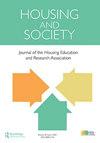节能经济适用房:加拿大城市的政策设计和实施
Q2 Social Sciences
引用次数: 0
摘要
在加拿大,社会住房被定义为政府为在私人市场上负担不起足够和合适住房的个人提供的补贴住房。这种住房支持通常是与私人和公共非营利组织合作提供的(住房服务公司,2013年)。《节能经济适用住房:加拿大城市的政策设计与实施》探讨并分析了加拿大各省市节能计划对社会住房的各种方法及其影响。本书探讨了联邦、省和地方政府之间与能源效率有关的关系,并提出了几种利用公共和私人资源的创新方法,通过改造和其他改进来提高可负担性。这本书分为八个部分,包括引言、对联邦和省级政策的回顾,重点是提高现有住房的能源效率,五章调查各省的能源效率计划和努力。最后一章着重介绍了未来的发展方向。加拿大经济行动计划(CEAP)资助了节能改造和其他旨在在经济衰退期间刺激经济和创造就业机会的项目。此外,CEAP还包括绿色基础设施基金,该基金针对的是未来专注于改善环境质量和可持续性的项目。第一章,引言,可持续经济适用房的节能改造和政策设计,列出了本书中涉及的四个研究目标:本文章由计算机程序翻译,如有差异,请以英文原文为准。
Energy efficient affordable housing: policy design and implementation in Canadian cities
In Canada, social housing is defined as government-subsidized housing for individuals who cannot afford adequate and suitable housing in the private market. This housing support is often offered in partnership with private and public nonprofit organizations (Housing Services Corporation, 2013). Energy Efficient Affordable Housing: Policy Design and Implementation in Canadian Cities explores and analyzes the various approaches to and impact of energy efficiency programs on social housing in various Canadian cities and provinces. This book addresses the relationship between federal, provincial, and local governments related to energy efficiency, and presents several innovative approaches to leveraging public and private resources to improve affordability through retrofits and other improvements. The book is organized into eight sections, with an introduction, a review of federal and provincial policies focused on improving the energy efficiency of existing housing stock, five chapters investigating energy efficiency programs and efforts in various provinces. It concludes with a chapter focused on future directions. The Canadian Economic Action Plan (CEAP) funded energy-efficient improvements and other programs aimed at stimulating the economy and creating jobs during the recession. Additionally, the CEAP included the Green Infrastructure Fund that targeted projects focused on improving environmental quality and sustainability into the future. Chapter 1, the introduction, Energy Efficient Retrofits and Policy Design for Sustainable Affordable Housing, lists the four research objectives addressed in this book:
求助全文
通过发布文献求助,成功后即可免费获取论文全文。
去求助
来源期刊

Housing and Society
Social Sciences-Urban Studies
CiteScore
2.30
自引率
0.00%
发文量
10
期刊介绍:
Housing and Society is the journal of the Housing Education and Research Association (HERA). The journal supports the mission of HERA by providing for the dissemination of research and other scholarly work. Submissions from a broad range of perspectives are encouraged. Topics in housing include: policy, design, social aspects, gerontology, behavioral aspects, energy/environment, equipment, interiors, economics, theory/model development, education, and program development or evaluation. The journal welcomes the submission of original research articles, notes and commentaries. Notes are shorter manuscripts presenting succinct information on housing related to one of the following categories: - Research: exploratory or not heavily theory-based or statistically analyzed - Academic: innovative teaching ideas - Program: development, implementation, and/or evaluation of Cooperative Extension or other housing programming efforts - Policy: examination of policy impact, comparative analysis, and/or need to achieve housing goals - Reviews: books, documentaries, etc.
 求助内容:
求助内容: 应助结果提醒方式:
应助结果提醒方式:


